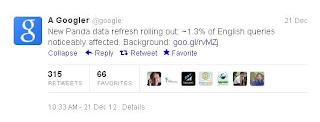Google New Panda Refresh on 21st December 2012
On 21st December 2012, Google official announced the new Panda refresh. This time approximately 1.3% English queries were noticeably affected. Google announced this Panda refresh through Twitter. If you are a follower of Google on Twitter then we believe you have been notified of this update and if you missed this update then you can find all details about this update here.
Here is the Google official announcement on www.twitter.com/Google regarding the Panda data refresh which was published by Google on the 21st of December 2012. Just before 4 days from Christmas!
Many webmaster around the world were very shocked to see this Panda refresh before the holiday season, because last year Google did not refresh Panda before the holiday season. This year webmasters were thinking that Google would have a new refresh in January 2013, but they surprised everyone by completing it early.
Have You Noticed Change in Traffic or Drop in Ranking After this Panda Refresh?
Many webmasters around the world have started discussing this Panda refresh. Some noticed a small change in their traffic, and some notice huge drop in rankings. You can see people are discussing about this panda refresh here at Webmaster World
Top 10 Tips to Recover from Google Panda
Google always recommends making a high quality website to recover from a Panda refresh and some important points to consider for a high quality website are as follows:
1) Write quality content for your website.
2) Remove duplicate content or duplicate pages from your website.
3) Write user friendly content.
4) Check all spelling or grammar mistakes before publishing your content in the website.
5) Write some user interested articles on your website.
6) Ignore short articles. Be specific and try to provide to-the-point topic and content in your website.
7) Provide faithful content in your website.
8) Ignore keyword stuffing in your website.
9) Make your website clean.
10) Write for users not for search engines.
Hopefully these tips related to recover from the Google Panda update will be useful for your website. If you have any doubts or questions related to these then you can contact us at any time.
Also, if you are a new to the internet & search engine world and do not know how to design a high quality website and high quality content for your website then do not be panic. Just visit www.SEOCopyKids.com, and find out the SEO Solution for your website by hiring us at very affordable prices.
On 21st December 2012, Google official announced the new Panda refresh. This time approximately 1.3% English queries were noticeably affected. Google announced this Panda refresh through Twitter. If you are a follower of Google on Twitter then we believe you have been notified of this update and if you missed this update then you can find all details about this update here.
Here is the Google official announcement on www.twitter.com/Google regarding the Panda data refresh which was published by Google on the 21st of December 2012. Just before 4 days from Christmas!
Many webmaster around the world were very shocked to see this Panda refresh before the holiday season, because last year Google did not refresh Panda before the holiday season. This year webmasters were thinking that Google would have a new refresh in January 2013, but they surprised everyone by completing it early.
Have You Noticed Change in Traffic or Drop in Ranking After this Panda Refresh?
Many webmasters around the world have started discussing this Panda refresh. Some noticed a small change in their traffic, and some notice huge drop in rankings. You can see people are discussing about this panda refresh here at Webmaster World
Top 10 Tips to Recover from Google Panda
Google always recommends making a high quality website to recover from a Panda refresh and some important points to consider for a high quality website are as follows:
1) Write quality content for your website.
2) Remove duplicate content or duplicate pages from your website.
3) Write user friendly content.
4) Check all spelling or grammar mistakes before publishing your content in the website.
5) Write some user interested articles on your website.
6) Ignore short articles. Be specific and try to provide to-the-point topic and content in your website.
7) Provide faithful content in your website.
8) Ignore keyword stuffing in your website.
9) Make your website clean.
10) Write for users not for search engines.
Hopefully these tips related to recover from the Google Panda update will be useful for your website. If you have any doubts or questions related to these then you can contact us at any time.
Also, if you are a new to the internet & search engine world and do not know how to design a high quality website and high quality content for your website then do not be panic. Just visit www.SEOCopyKids.com, and find out the SEO Solution for your website by hiring us at very affordable prices.





